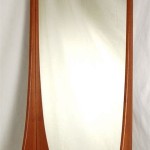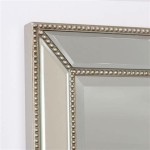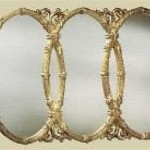DIY Vanity Mirror with LED Strip Lights: A Comprehensive Guide
Creating a vanity mirror with LED strip lights is a popular and relatively simple DIY project that can significantly enhance a dressing table or bathroom. This project allows for personalized aesthetics and functional lighting, ultimately improving the makeup application process and overall ambiance of the space. The finished product offers direct, even illumination, minimizing shadows and providing a clearer reflection for detail-oriented tasks. This article provides a detailed guide to constructing a vanity mirror with LED strip lights, covering the necessary materials, tools, and step-by-step instructions.
Before embarking on this DIY project, careful planning is crucial. Consider the size and shape of the mirror, the desired brightness and color temperature of the LED lights, and the power source and wiring considerations. Thorough preparation will ensure a successful and satisfactory outcome.
Key Point 1: Planning and Preparation
The planning phase is essential to determine the necessary materials and ensure the final product meets your specific needs. Begin by establishing the desired size and shape of the mirror. This will dictate the dimensions of the plywood or MDF backing, the length of the LED strip lights, and the overall aesthetic of the finished product. Consider whether a rectangular, square, round, or custom-shaped mirror best suits the space and personal preferences.
Next, decide on the type and specifications of the LED strip lights. Options range from warm white to cool white, and even color-changing (RGB) LEDs. The color temperature, measured in Kelvin (K), influences the overall mood. Warmer temperatures (2700-3000K) offer a soft, inviting glow, while cooler temperatures (4000-5000K) provide a brighter, more daylight-like illumination. The brightness, measured in lumens, will determine the intensity of the light. Consider the overall ambient lighting in the room to choose an appropriate lumen output.
Determine the power source for the LED strip lights. Options include plugging the lights into a wall outlet or hardwiring them into the electrical system. Plugging into an outlet is generally simpler and requires a power adapter. Hardwiring offers a cleaner look but requires more electrical knowledge and may necessitate the assistance of a qualified electrician. Always adhere to local electrical codes and regulations.
Finally, consider the method of attaching the LED strip lights to the mirror or backing. Common options include adhesive backing on the LED strip lights themselves, or using clips or channels specifically designed for securing LED strips. The chosen method must be secure and discreet, ensuring the lights are evenly spaced and properly positioned.
Materials Required:
- Mirror (size and shape determined by preference)
- Plywood or MDF board (for backing, slightly larger than the mirror)
- LED strip lights (length and color temperature as desired)
- Power adapter (if plugging into an outlet) or wiring supplies (if hardwiring)
- Wood glue or mirror adhesive
- Screws (for attaching the mirror to the backing)
- Sandpaper (for smoothing edges of the plywood/MDF)
- Primer and paint (optional, for finishing the backing)
- Clear silicone caulk (to seal the edges of the mirror)
- LED strip light clips or channels (optional, for added security)
Tools Required:
- Measuring tape
- Pencil
- Saw (for cutting the plywood/MDF)
- Drill (with appropriate drill bits)
- Screwdriver
- Clamps (for securing the mirror while the adhesive dries)
- Soldering iron and solder (if connecting wires)
- Wire stripper
- Multimeter (for testing electrical connections)
- Safety glasses
- Gloves
Key Point 2: Construction and Assembly
Once all the necessary materials and tools have been gathered, the construction and assembly process can begin. This involves preparing the backing, attaching the mirror, installing the LED strip lights, and managing the wiring.
Begin by preparing the plywood or MDF backing. Cut the board to the desired size, ensuring it is slightly larger than the mirror. Sand the edges smooth to remove any splinters or rough spots. Apply primer and paint to the backing, if desired. This will provide a finished look and protect the wood from moisture. Allow the paint to dry completely before proceeding.
Next, attach the mirror to the backing. Apply wood glue or mirror adhesive to the back of the mirror and carefully position it onto the center of the backing board. Use clamps to secure the mirror in place while the adhesive dries. Follow the manufacturer's instructions for drying time. Avoid using adhesives that could damage the mirror's reflective backing.
Once the adhesive is dry, carefully drill pilot holes through the backing and into the mirror frame. Use screws to further secure the mirror to the backing. Ensure the screws are not too long, as they could protrude through the front of the mirror. Screws provide additional stability and prevent the mirror from shifting over time.
Now, install the LED strip lights. Determine the placement of the LED lights around the perimeter of the mirror. Options include placing them directly on the back of the mirror, on the inside edge of the backing board, or in a channel specifically designed for LED strips. If using adhesive backing on the LED strips, carefully peel off the protective layer and press the strips firmly into place. If using clips or channels, secure the LED strips into the clips or channels before attaching them to the backing.
Pay close attention to the spacing of the LED strips to ensure even illumination. Avoid overlapping or crimping the strips, as this can damage the lights. Consider using corner connectors to make clean transitions around the corners of the mirror frame.
Finally, manage the wiring for the LED strip lights. If using a power adapter, connect the adapter to the LED strips according to the manufacturer's instructions. If hardwiring the lights, consult with a qualified electrician to ensure the wiring is done safely and correctly. Use wire strippers to expose the ends of the wires and securely connect them using solder or wire connectors. Use a multimeter to test the connections and ensure the lights are receiving power.
Key Point 3: Wiring and Electrical Safety
Electrical safety is paramount when working with LED strip lights, particularly if hardwiring the system. Improper wiring can lead to electrical shocks, fires, or damage to the lights themselves. Adherence to safety guidelines and local electrical codes is crucial.
Before beginning any wiring work, disconnect the power supply at the circuit breaker. Use a voltage tester to confirm that the power is off. This precaution prevents accidental electrical shock.
When hardwiring the LED strip lights, use appropriately sized wires that are rated for the voltage and current of the system. Consult with an electrician to determine the correct wire gauge for the application. Smaller gauge wires may overheat and pose a fire hazard.
Ensure all connections are secure and properly insulated. Use wire connectors or solder to create reliable electrical connections. Wrap exposed wires with electrical tape to prevent short circuits. Avoid leaving any bare wires exposed.
Protect the wiring from damage by routing it through conduit or using wire staples. This prevents the wires from being accidentally cut, pinched, or pulled. Proper wiring protection extends the lifespan of the electrical system and reduces the risk of electrical hazards.
If using a power adapter, ensure it is compatible with the LED strip lights. The adapter should provide the correct voltage and current. Using an incompatible adapter can damage the lights or cause them to malfunction.
Include a fuse or circuit breaker in the wiring circuit to protect against overloads and short circuits. This safety device will automatically disconnect the power supply in the event of a fault, preventing damage to the system and reducing the risk of fire.
If unsure about any aspect of the wiring process, consult with a qualified electrician. Electrical work should only be performed by individuals who are trained and experienced in electrical safety practices.
After completing the wiring, test the system thoroughly before using it. Turn on the power and verify that the LED strip lights are functioning correctly. Check for any signs of overheating, flickering, or other malfunctions. If any problems are detected, disconnect the power and troubleshoot the issue before continuing.
Finally, seal the edges of the mirror with clear silicone caulk. This will prevent moisture from seeping between the mirror and the backing, which can damage the reflective backing and cause the mirror to delaminate. Apply a thin, even bead of caulk around the perimeter of the mirror and smooth it with a wet finger. Allow the caulk to dry completely before using the vanity mirror.

Diy Vanity Mirror I Used Any And Led Strip Lights Closet Lighting

How To Diy Vanity Mirror With Led Strip Lights

How To Make A Vanity Or Bathroom Mirror With Strip Lights

Diy Vanity Mirror With Lights

Easy Diy Led Light Up Vanity Mirror With Remote Tutorial By Yanaglo

How To Diy Vanity Mirror With Led Strip Lights

Diy Full Vanity Mirror Rgb Strip Lights

Diy Led Light Strips For Mirror Practical Advice Nakashi Lighting

Bright Soft Light Led Strip Kit For Diy Vanity Mirror 13ft

14 Pcs Led Makeup Mirror Lights Dimmable Touch Control Vanity Bathroom Light With Usb Cable Strip Dressing Com








